Shakshuka is a Tunisian one pan dish of eggs in tomato sauce. This simple but flavorful dish is perfect for breakfast, lunch or dinner. We skipped the sausage in this recipe that would normally be served with sausages so feel free to add them in if you want!
What is Shakshuka?
Shakshouka is a dish of tomatoes, spices, and eggs that is baked together. It originated in North Africa(Tunisia) and is now popular in Israeli and Palestinian cuisine. You can eat it for breakfast or brunch
This Tunisian one pan dish is also a quick and easy dish to make that is perfect for busy days.
What are the ingredients of a Shakshouka Recipe?
Poached eggs
Shaksouka is a popular dish that typically contains poached eggs and a tomato sauce simmered in aromatic spices of cumin and paprika. Shakshouka can be adjusted to fit the needs of the cook, such as by adding or subtracting ingredients. It is popular because it is easy to make and can easily be customized with different garnishings and optional sides.
Tomato sauce
Fresh ripe tomatoes and tomato paste creates a good thicky and brothy base for poaching the eggs.
The Aromatic Spices
Garlic is a staple in Shakshuka, adding flavour and health benefits. It is used to cook the eggs in the tomato sauce, and its fumes help to prevent spoilage. Olive oil and garlic are also used to cook the eggs. Bell peppers and cherry or grape tomatoes are also used in Shakshuka. Ground cumin, paprika and chili powder add spice to the dish.
Is Shakshouka the same as Chakchouka, or Shakshuka?
Yes! It’s easier to make that it is to spell! They are all the same thing – a spicy egg dish with tomatoes and spices.
How to make Shakshouka (AKA Chakchouka, AKA Shakshuka)?
Step 1: Spices and Tomatoes
In a skillet or cast iron pan, add oil of choice – such as ghee or coconut oil – and stir fry aromatic spices of garlic and onions until soft. Top with fresh tomatoes and tomato sauce, stir briefly. Then add in the other spices of cumin, paprika, and thyme.
Cover and let cook in the cast iron for around 4 minutes.
Step 2: Poach the eggs
Create a well or pockets in the mixture and crack eggs to each well – do this gently – you want to keep the eggs whole. Jostle ever so slightly – keep the eggs whole but let some of the whites permeate through
Reduce the heat to medium-low and simmer for 2 minutes.
Step 3: Sprinkle with parsley and serve with (optional) bread.
You can cook the eggs a little more to your liking at this point. Garnish with parsley and eat by itself (it’s yummy as-is), or eat it with a side of toasted bread! This is typically a tomato breakfast dish but no shame in eating them for brunch or lunch! Especially when you pair it with a side of pita bread or garlic toast for dipping into the delicious aromatic flavors.
Storage
Shakshouka is a great dish to make in large batches and store for later. It can be stored in the fridge for up to 3 days or frozen for up to 2 months.
FAQs
What are some of the different ways to eat shakshuka?
There are many ways to eat this chakchoua recipe, depending on your preferences. It can be made vegetarian or with meat ingredients.A traditional shakshuka recipe mainly comprise of a dish made of eggs and tomoatoes plus some fragrant spices.
Whereas it’s very similiar to the breakfast dish huevos rancheros, shakshuka is often served as an evening meal in different parts of the world.
For example, Huevos a la flamenca is a popular Andalusian dish that includes chorizo and ham.
In Italian cuisine, there is a version of shakshuka called uova in purgatorio that includes tomato paste, anchovy, garlic, basil or parsley, and sometimes parmesan cheese.
What are some of the tips for making the perfect shakshuka?
Shakshuka is a hot, tomato-based stew popular in Israel. To make the perfect shakshuka, follow these tips:
1. Prepare the sauce ahead of time and store leftovers in the fridge.
2. Use a good quality olive oil and high quality vegetables and spices.
3. If using canned tomatoes, add tomato sauce to taste.
4. Use fresh eggs in shakshuka.
5. Add chopped parsley and mint before serving
Shakshouka is one of those fantastic dishes that works anytime, anywhere.

Where does Shakshouka come from?
For a dish that’s so well loved, one of the most contentious aspects of shakshouka is its place of origination. It’s a highly popular and well frequented recipe all around the Mediterranean but particularly in Northern African countries like Libya, Algeria, Morocco and Tunisia.
Technically, credit for shakshouka is mostly given to the Tunisians, but even then you might still hear quips and qualms about this as well. One of the main reasons for this is, in fact, because the basis for the shakshouka recipe draws on principles more common to the cuisine of the Sephardic Jews than anyone else. In case they sound familiar, we’ve already seen the culinary influence of the Sephardic Jews on Spanish cuisine and ultimately into Cuba’s favorite ropa vieja.
But the Sephardic influence was not at all confined to the geographies of the Iberian Peninsula. Imprints of the Sephardic culture – who at one point made up more than 90% of the world’s Jewish population – can be felt from North Africa to Greece to modern-day Turkey and Iraq.
One of the greatest touchpoints of this wide-ranging Sephardic influences comes in food. Sephardic cooking emphasizes abundant use of olive oil, aromatic (if not hot) spices and powerful tasting ingredients like garlic and lemons. These elements are all present in a recipe like shakshouka just as they are in similar Sephardic-inspired “cousin” recipes like menemen (Turkish), pisto manchego (Spanish) and huevos rancheros (Mexican).
Shakshouka itself though – never mind the quabbles around which modern day country deserves credit – is distinctly indigenous to Northern Africa and almost certainly originated in the region. Contemporary consumption of shakshouka has become more globally widespread, quickly becoming a popular dish for a nascent Jewish state of Israel, but it is still very much a byproduct of North African cooking styles.
How its name came about, however, is a little bit more up in the air. There are three possible theories for why shakshouka is named the way it is:
- The name shakshouka itself comes from Arabic slang meaning “a mixture”
- It is a variant on the word chakchouka, a Berber word for vegetable ragout
- Given the Sephardic Jewish influence, the name is a long derivative from the Hebrew verb leshakshek, or “to shake”
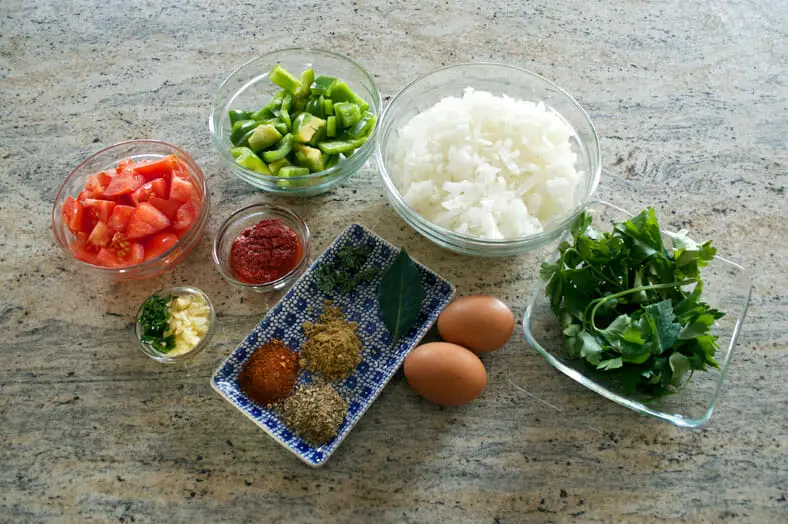
About the Recipe
Certainly all three naming theories lend credence to how the recipe is actually prepared. At its core essence, shakshouka consists of eggs poached in a vegetable ragout that is heavily spiced and very powerful in flavor.
The base of the ragout usually starts with tomatoes, garlic, onions and green bell peppers. These ingredients are fried in olive oil and are broken down to form the ragout, at which point spices and additional flavors are added. In some areas of Tunisia and elsewhere, shakshouka might be also made with zucchini, potatoes, beans and/or artichoke hearts, but these are more optional enhancements to the base requisite ingredients.
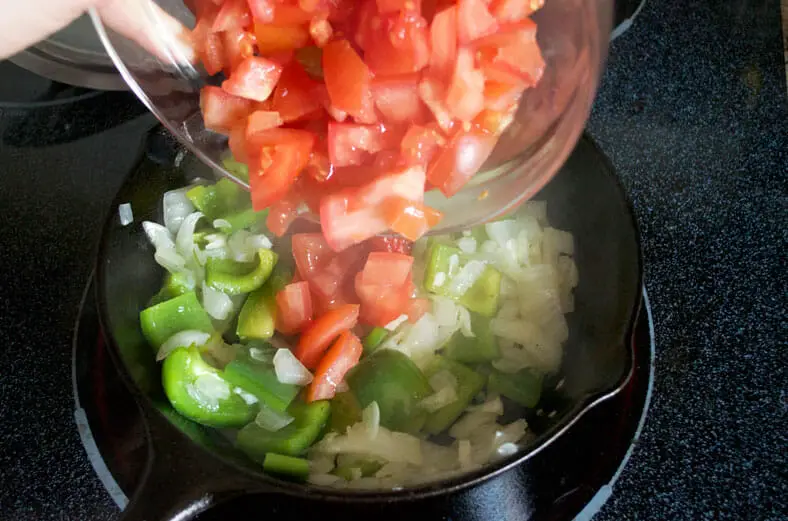
In a dish like shakshouka, the types of spices you choose will have a particularly great influence over the final outcome of the dish. The most common spices used here will be cumin, paprika and black pepper, in that order, but additional regional spices like harissa or ras el hanout can also be used. Again, the choices here will affect the ragout that poaches the egg and brings together the final dish.
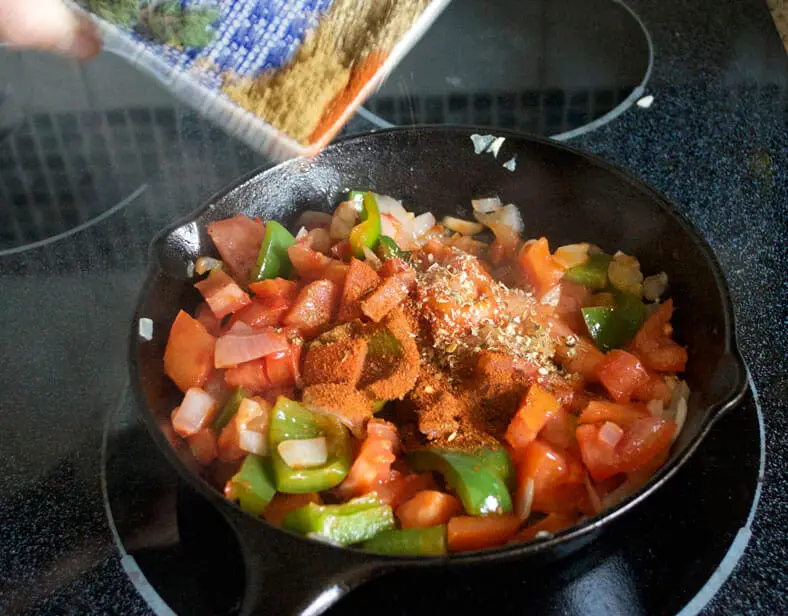
Finally, the eggs are added to the pan on top of the ragout. One fun (and aesthetically appeasing) tactic to use here would be to create little wells where the egg can fall into and from where the egg white can permeate through the rest of the dish. Once the egg is added, though, you will cover the pan and let the eggs poach in the ragout and steam until cooked and the shakshouka is ready to eat.
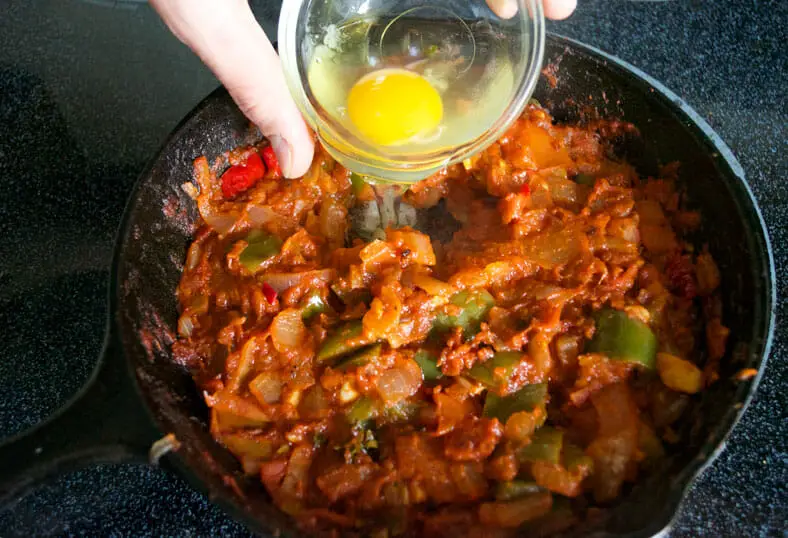
When serving, shakshouka is most traditionally eaten with bread, which can be especially helpful to mop up runny yolks. Merguez, or spicy sausage, is also a very common and tasty accompaniment to eat alongside shakshouka as well. Sausages and eggs go so well together for breakfast the Scottish eats them by using sausage and panko to fully encase a hard boiled egg and then the whole thing is deep fried. It makes my mouth water writing this sentence!
Our Take on the Recipe
As elegant as our original reference recipe is, we did make some reasonable adjustments to our version of the recipe.
For one, the original recipe doesn’t include any types of spices, such as black pepper and cumin, we found prevalent in other versions of the recipe. Not only did we add those back into this one, but we also dabbled a bit with ras el hanout. The latter ingredient had a grand effect on the recipe, but it is more an optional add than anything else.
Also, in order for shakshouka to be more readily enjoyed by others, we omitted the merguez (sausage) from our version and kept this recipe vegetarian-friendly. Since it was a removal of an accompaniment, it wasn’t a big deal at all to the actual shakshouka, although it can be a tasty addition if you so desire.
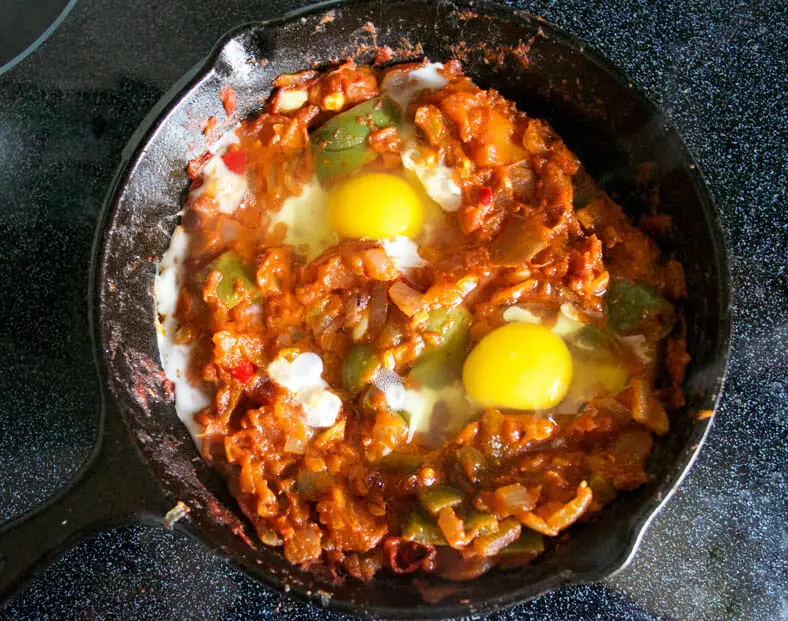
Other than that, regardless of where it’s from, shakshouka is a delightful, simple and very quick recipe to make. Best of all, it’s perfect to enjoy any time of the day.
Enjoy!
How do you prepare your shakshouka? Comment below!



Shakshouka (Shakshuka) Egg and Tomato One Pan Recipe
- Total Time: 25 minutes
- Yield: 2 people 1x
Description
Shakshouka with tomatoes, poached eggs, spices of cumin and paprika, simmered in cast iron. Eat as breakfast or lunch! Serve with side of pita bread or garlic toast for dipping!
Ingredients
- 3 cloves of garlic, minced
- ¼ cup olive oil
- 1 onion, diced
- 1 green bell peppers, cubed and roughly chopped (if you’d like to dice more finely, totally fine too)
- 1½ tablespoons tomato paste
- 2 big ripe tomatoes, cubed
- 2 eggs
- 1 teaspoon cumin
- 1 bay leaf
- 1 teaspoon thyme
- 1 teaspoon harissa (or substitute with paprika powder, but harissa is best)
- 1 teaspoon black pepper
- 1 teaspoon ras el hanout (optional)
- 1 teaspoon sea salt
- 1 handful of parsley, chopped (for garnish)
- Extra salt and pepper to taste
Instructions
Stage 1
- Take a cast iron pan or a shallow skillet (we preferred cast iron for this recipe) and put over medium-high heat
- Once the pan is warmed, add your olive oil
- Once olive oil is warmed, add the onions and garlic and stir around for 2-3 minutes as the onions start to sweat
- Next, add your green bell peppers and stir around for another 2-3 minutes
- Add the tomatoes, tomato paste, and bay leaf. Stir briefly before adding the cumin, thyme, harissa, black pepper, sea salt, and ras el hanout (if added)
- Stir around for another 1 minute, but this time also occasionally mash the tomatoes with your spoon to help break them up
- Cover your pan and let everything cook together for another 4 minutes
Stage 2
- As your pan is covered and everything is cooking together, crack your eggs into a small bowl or ramekin. This will make it easier to place them gently into the pan without breaking
- After 4 minutes, uncover your pan and use a ladle to create tiny wells or pockets in the mixture to put your eggs
- Pour your eggs from the ramekin into the well and jostle ever so gently. You don’t want the egg to break, but you want some of the egg white to permeate through the rest of the mixture
- After a slight jostle, cover your pan again and let the eggs cook/steam for 2 minutes
- After 2 minutes (making sure your eggs are fully cooked), take the pan off the heat and sprinkle your parsley over as garnish
- Prep Time: 10 mins
- Cook Time: 15 mins
- Category: Breakfast
- Cuisine: Tunisian
